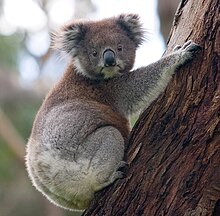Drop bear
[9] Other early appearances in print include a Royal Australian Navy News article in 1978[10] and a classified advertisement in the Canberra Times in 1982.Stories about drop bears are generally used as an in-joke intended to frighten and confuse outsiders while amusing locals, similar to North American "fearsome critters" such as the jackalope.[12][13] These tales are often accompanied by advice that the hearer adopt various tactics purported to deter drop bear attacks—including placing forks in the hair, having Vegemite or toothpaste spread behind the ears or in the armpits, urinating on oneself, and only speaking English in an Australian accent.The entry classifies the drop bear as Thylarctos plummetus and describes them as "a large, arboreal, predatory marsupial related to the koala", the size of a leopard, having coarse orange fur with dark mottling, with powerful forearms for climbing and attacking prey, and a bite made using broad powerful premolars rather than canines.[24] Incisions on bones of the extinct kangaroo Macropus titan suggest Thylacoleo fed in a similar way to modern cheetahs, using their sharp teeth to slice open the ribcage of their prey, thereby accessing the internal organs.
Dropbear (software)Dropbear (disambiguation)Australian folklorepredatorycarnivoroustall talestouristsherbivoresmarsupialsThylacoleohypercarnivorousLate PleistoceneThe Paul Hogan Showhoop snakesDropbearsin-jokefearsome crittersjackalopeVegemiteurinatingAustralian Museumleopardpremolarscaninessilly seasonAustralian GeographicApril Fools' DayAustralian GeographerBundaberg RumDiscworldThe Last ContinentTerry PratchettNatureambush predatorsMacropus titancheetahsGarkainWild HaggisHoop snakePacific Northwest tree octopusSnipe huntYara-ma-yha-whoCastlemaine XXXXWayback MachineJames Cook UniversityBibcodeCryptozoologyList of cryptidsCryptozoologistsHenry H. BauerJon-Erik BeckjordJohn BindernagelPeter C. ByrneDavid Hatcher ChildressLoren ColemanWilliam R. CorlissPeter CostelloTim DinsdaleRichard EllisRichard FreemanCharles GouldRupert GouldJohn Willison GreenRichard GreenwellBernard HeuvelmansRalph IzzardJohn KeelAleksandr KondratovGrover KrantzWilly LeyRoy MackalVladimir MarkoticJeffrey MeldrumJohn R. NapierMichael NewtonAnthonie Cornelis OudemansDavid PaulidesBoris PorshnevIvan T. SandersonKarl ShukerGardner SouleRoderick SpragueOdette TchernineAnimalia ParadoxaArthur C. Clarke's Mysterious WorldBeast HunterBeast LegendsDestination TruthExotic ZoologyExtinct or AliveFortean TVIn Search of...Is It Real?Lost TapesMonsterQuestMonsters and Mysteries in AmericaOn the Track of Unknown AnimalsStrange Abominable SnowmenThe Hunt for the BuruThe Sasquatch and Other Unknown HominoidsThe X CreaturesThe Secret SaturdaysWeird TravelsJoshua Blu BuhsRobert Todd CarrollSteuart CampbellPeter DendleBrian DunningSharon A. HillHenry LeeDaniel LoxtonSherrie Lynne LyonsDarren NaishJoe NickellDonald ProtheroBenjamin RadfordBrian RegalMichael ShermerGeorge Gaylord SimpsonBiologyFolklore studiesHypothetical speciesPseudoscienceYoung Earth creationismZoology